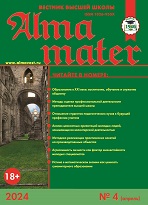UDC 378+614-053
https://doi.org/10.20339/AM.07-22.064
Natalia A. Popovanova, Cand. Sc. (Pedagogy), Docent, Head of the Department Physical culture and Health at Krasnoyarsk State Pedagogical University named after V.P. Astafyev, e-mail: fkreferat@mail.ru
Vladimir S. Zommer, Senior lecturer in the Department of Physical education and Health at Krasnoyarsk State Pedagogical University named after V.P. Astafyev, e-mail: vz_forward@mail.ru
The article presents the views of scientists on the problem of student youth health saving, justifies the need to create a health-saving space in higher educational institutions. A contradiction between the society’s need for healthy student youth and the undeveloped system of a health-saving environment in higher educational institutions is revealed. The relevance and importance of the axiological approach to the process of formation of the health-saving space of the university is considered. A structural-functional model of the health-saving space of the university is presented, consisting of three components: cognitive, value and activity-effective. The main characteristics of the health-saving space are determined and the content of health-saving technologies aimed at preserving the student's health as a subject-object of the educational process is disclosed. The experience of creating a health-saving space in the Krasnoyarsk State Pedagogical University named after V.P. Astafiev in order to train competitive specialists. It is substantiated that the proposed structural and functional model of a health-saving space can be successfully used to design such spaces on the basis of a particular institution.
Key words: health, students, values, axiological approach, model, physical culture, health-saving space, Pedagogical University.
References
- Abaskalova, N.P. Systematic approach in the formation of a healthy lifestyle of the subjects of the educational process (school-university): abstract of the thesis dis. … Dr. Sc. (Pedagogy). Novosibirsk, 2001. 48 p.
- Bezrukikh, M.M. Health-saving pedagogy. Moscow: Psychological and Social Institute, 2004. 240 p.
- Biryukova, Yu.N. Formation of a healthy lifestyle among students of secondary schools based on health-saving technologies: abstract of the thesis dis. … Cand. Sc. (Pedagogy). Krasnodar, 2004. 23 p.
- Vakhitova, G.A. Formation of health-saving technologies in adolescent children in a non-state educational institution: abstract of the thesis. dis. … Cand. Sc. (Pedagogy). Ufa, 2007. 25 p.
- Elkova, L.S. Formation of a health-saving educational space of higher school: abstract of the thesis. dis. … Cand. Sc. (Pedagogy). Moscow, 2006.
- Zhuykova, T.P. Ideas of values, their development in general axiology. Young scientist. 2014. No. 21 (80). P. 632–634.
- Podgornaya, O.E. Designing a health-saving space of a general education school by means of personality-oriented education: Dis. of. Cand. Sc. (Pedagogy). Tiraspol, 2005. 211 p. RSL OD, 61:05-13/2000
- Popovanova, N.A., Kravchenko, V.M., Chizhakova, G.I., Sommer, V.S. Structural and functional model of an open health-preserving space. Physical culture and health. 2022. No. 1 (81). P. 171–175.
- Popovanova, N.A., Chizhakova, G.I., Kazakova, G.N. Formation of a value attitude to health among students with disabilities in the process of implementing health-saving technologies in a pedagogical university. Alma mater. (Vestnik vysshei shkoly). 2020. No. 7. P. 48–51. DOI: 10.20339/AM.07-20.048
- Smirnov, N.K. Health-saving educational technologies in modern school. Moscow, 2002. 121 p.
- Driving social impact with common global indicators for healthy lifestyle programs: lessons learned / N.R. Robinson, J. Gin, S. Kamath-Jha, M. Infantes, R. Hernandes, M. Alberg-Seberich, D. Suri, R. Perez-Esxamilla. Food and Nutrition Bulletin. 2014. Vol. 35. P. 163–168. URL: http://elibrary.ru/item.asp?id=24488032
- Identifying common metrics for evaluating school-based healthy lifestyles programs in seven countries: introduction to workshop proceedings / R. Perez-Escamilla, M. Albert-Seberich. Food and Nutrition Bulletin. 2014. Vol. 35. P. 93–96. URL: http://elibrary.ru/item.asp?id=24488036
- Policy, system, and environment strategies to promote physical activity and healthy food sources to address guam`s disparate non-communicable disease burden / M. Nitta, D. Navasca, N.A. Palafox, C. Tanner, K. Narvarte, R. Zabala, P. Luces, A. Silverio, A. Sy. Journal of Health Care for the Poor and Underserved. 2015. Vol. 26. No. 2. P. 96–103. URL: http://elibrary.ru/item.asp?id=24445021











.png)






